Huge, bear-like Heinrich George (1893–1946) was a famous German stage and film actor of the Weimar republic. He starred in such classics as Metropolis (1926) and Berlin Alexanderplatz (1931). Under the Nazi regime, the former Communist was initially not permitted to work but he later appeared in notorious propaganda films as Jud Süss (1940). After the war he died of starvation in a Soviet concentration camp.
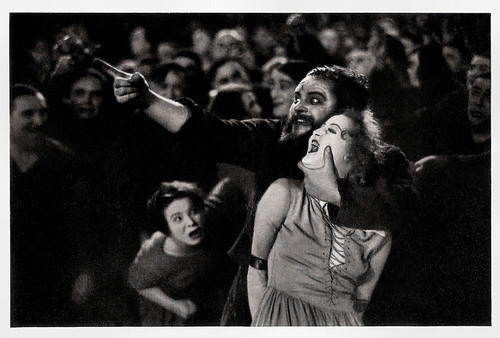
German collectors card by Ross Verlag in the series Vom Werden Deutscher Filmkunst - Der Stumme Film, picture, picture no. 143, group 43. Photo: Ufa. Caption: "Heinrich George plays the scene".

Small German collector card in the Bunte Filmbilder series by G. Zuban, München, no. 190. Photo: Badal / Terra. Publicity still for Stjenka Rasin/Stenka Rasin (Alexandre Volkoff, 1936).
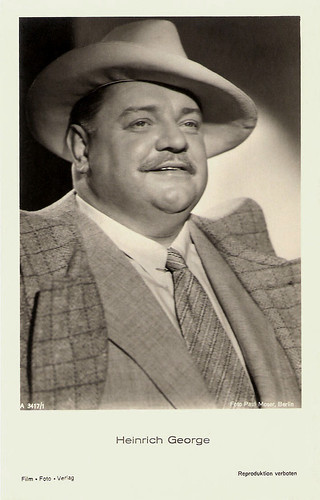
German postcard by Film-Foto-Verlag, no. 3417/1, 1941-1944. Photo: Paul Moser, Berlin.
Heinrich George was born Georg August Friedrich Hermann Schulz in Stettin, Pomerania, Germany (now Szczecin, Zachodniopomorskie, Poland) in 1893. He was the son of former naval officer August Schulz.
Before graduation, he left his school in Berlin and went to Szczecin for acting lessons. In the summer of 1912, only 19, he made his stage debut in Kolberg as head waiter in the operetta Die keusche Susanne (The Chaste Susanne) by Jean Gilbert.
After more stage engagements in Bromberg (now Bydgoszcz) and Neustrelitz, he volunteered in the First World War and was severely wounded in the winter of 1915. After his recovery, he worked in Dresden at the Albert-Theater (1917-1918), in Frankfurt am Main at the Schauspielhaus (1918-1921) and in Berlin at the Deutsches Theater (1921) under Max Reinhardt.
During the 1920s, he became one of the most renowned actors of the Weimar Republic with classic performances as Wallenstein, Falstaff, and Faust. He worked under such famous left-wing directors as Erwin Piscator and Bertolt Brecht. George reportedly spooked the young Brecht in his first directing job, a production of Arnolt Bronnen's Parracide (1922), when he refused to continue working with the director.
George was a member of the VDSt Greifswald and was active in the Communist Party of Germany. In 1923 he founded Das Schauspielertheater with the actors Elisabeth Bergner and Alexander Granach to be able to work as independent artists. Between 1925 and 1929 he mainly played at the Volksbühne in plays directed by Erwin Piscator. In addition, he appeared at the Heidelberg Theater Festival regularly (1926-1938). In 1927, he started directing stage plays himself.

German postcard by Verlag Ross, Berlin, no. 684/7. Photo: Carl-Wilhelm-Film / Terra Film. Theodor Loos and Heinrich George in the German silent film Soll und Haben/Debit and Credit (Carl Wilhelm, 1924), adapted from the novel by Gustav Freytag. The film had anti-Semitic and anti-Polish tendencies.
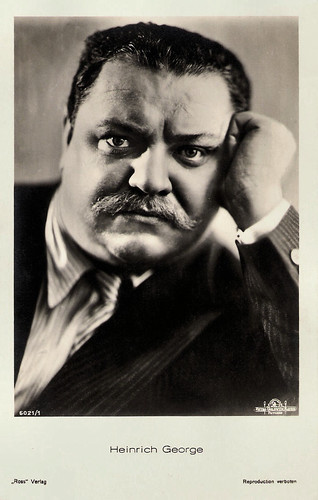
German postcard by Ross Verlag, no. 6021/1, 1931-1932. Photo: Metro-Goldwyn-Mayer. Publicity still for Menschen hinter Gittern/Men Behind Bars (Pál Fejös, 1931), German-language version of The Big House (George W. Hill, 1930), with Heinrich George in Wallace Beery's role, filmed by MGM parallel to the English-speaking version, at a time when good subtitles weren't yet in use.
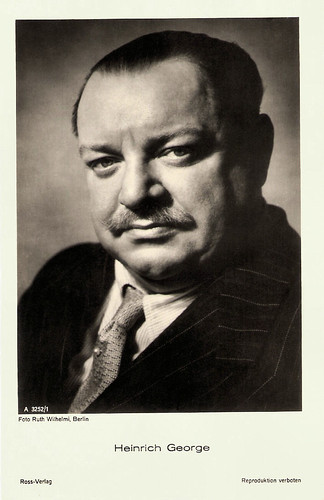
German postcard by Ross Verlag, no. A 3251/1, 1941-1944. Photo: Ruth Wilhelmi.
In 1921 Heinrich George was directed by Ludwig Berger in his first silent film, Der Roman der Christine von Herre/The Novel of Christine von Herre (1921). His other early film appearances were mainly supporting parts in such films as Kean (Rudolph Biebrach, 1921) with Alexander Moissi, Lucrezia Borgia/Lucretia Borgia (Richard Oswald, 1922) featuring Liane Haid, and the 'Lulu' adaptation Erdgeist/Earth Spirit (Leopold Jessner, 1923) starring Asta Nielsen.
In 1925 he appeared in the British fantasy film She (Leander De Cordova, G.B. Samuelson, 1925) starring Betty Blythe as She-Who-Must-Be-Obeyed of the frequently filmed H. Rider Haggard story. George had an important part in Fritz Lang‘s classic Metropolis (Fritz Lang, 1927) as Groth, the guardian of the Heart Machine. It was followed by several major parts in films by such directors as Richard Eichberg and Richard Oswald.
In Manolescu - Der König der Hochstapler/Manolescu (Viktor Tourjansky, 1929) he starred opposite the legendary Russian film star Ivan Mozzhukhin. Filmportal.de: “George became predominantly known as a film actor who portrayed characters that try to hide their sensibility behind a brutal attitude. His ‘massive appearance’ as well as his ‘elementary power’ were mentioned in nearly every contemporary review.”
He starred as the author Emile Zola in Dreyfus/The Dreyfus Case (Richard Oswald, 1930) opposite Fritz Kortner. In Berlin Alexanderplatz (Phil Jutzi, 1931), Heinrich George played his most famous role. In this first adaptation of the novel by Alfred Döblin, his Franz Biberkopf mesmerised both the public and the critics. It made him one of the most important film actors in Germany.

German collectors card by Ross Verlag in the series Vom Werden Deutscher Filmkunst - Der Stumme Film, picture, picture no. 143, group 43. Photo: Ufa. Caption: "Heinrich George plays the scene".

Small German collector card in the Bunte Filmbilder series by G. Zuban, München, no. 190. Photo: Badal / Terra. Publicity still for Stjenka Rasin/Stenka Rasin (Alexandre Volkoff, 1936).

German postcard by Film-Foto-Verlag, no. 3417/1, 1941-1944. Photo: Paul Moser, Berlin.
Spooking Bertolt Brecht
Heinrich George was born Georg August Friedrich Hermann Schulz in Stettin, Pomerania, Germany (now Szczecin, Zachodniopomorskie, Poland) in 1893. He was the son of former naval officer August Schulz.
Before graduation, he left his school in Berlin and went to Szczecin for acting lessons. In the summer of 1912, only 19, he made his stage debut in Kolberg as head waiter in the operetta Die keusche Susanne (The Chaste Susanne) by Jean Gilbert.
After more stage engagements in Bromberg (now Bydgoszcz) and Neustrelitz, he volunteered in the First World War and was severely wounded in the winter of 1915. After his recovery, he worked in Dresden at the Albert-Theater (1917-1918), in Frankfurt am Main at the Schauspielhaus (1918-1921) and in Berlin at the Deutsches Theater (1921) under Max Reinhardt.
During the 1920s, he became one of the most renowned actors of the Weimar Republic with classic performances as Wallenstein, Falstaff, and Faust. He worked under such famous left-wing directors as Erwin Piscator and Bertolt Brecht. George reportedly spooked the young Brecht in his first directing job, a production of Arnolt Bronnen's Parracide (1922), when he refused to continue working with the director.
George was a member of the VDSt Greifswald and was active in the Communist Party of Germany. In 1923 he founded Das Schauspielertheater with the actors Elisabeth Bergner and Alexander Granach to be able to work as independent artists. Between 1925 and 1929 he mainly played at the Volksbühne in plays directed by Erwin Piscator. In addition, he appeared at the Heidelberg Theater Festival regularly (1926-1938). In 1927, he started directing stage plays himself.

German postcard by Verlag Ross, Berlin, no. 684/7. Photo: Carl-Wilhelm-Film / Terra Film. Theodor Loos and Heinrich George in the German silent film Soll und Haben/Debit and Credit (Carl Wilhelm, 1924), adapted from the novel by Gustav Freytag. The film had anti-Semitic and anti-Polish tendencies.

German postcard by Ross Verlag, no. 6021/1, 1931-1932. Photo: Metro-Goldwyn-Mayer. Publicity still for Menschen hinter Gittern/Men Behind Bars (Pál Fejös, 1931), German-language version of The Big House (George W. Hill, 1930), with Heinrich George in Wallace Beery's role, filmed by MGM parallel to the English-speaking version, at a time when good subtitles weren't yet in use.

German postcard by Ross Verlag, no. A 3251/1, 1941-1944. Photo: Ruth Wilhelmi.
She-who-must-be-obeyed
In 1921 Heinrich George was directed by Ludwig Berger in his first silent film, Der Roman der Christine von Herre/The Novel of Christine von Herre (1921). His other early film appearances were mainly supporting parts in such films as Kean (Rudolph Biebrach, 1921) with Alexander Moissi, Lucrezia Borgia/Lucretia Borgia (Richard Oswald, 1922) featuring Liane Haid, and the 'Lulu' adaptation Erdgeist/Earth Spirit (Leopold Jessner, 1923) starring Asta Nielsen.
In 1925 he appeared in the British fantasy film She (Leander De Cordova, G.B. Samuelson, 1925) starring Betty Blythe as She-Who-Must-Be-Obeyed of the frequently filmed H. Rider Haggard story. George had an important part in Fritz Lang‘s classic Metropolis (Fritz Lang, 1927) as Groth, the guardian of the Heart Machine. It was followed by several major parts in films by such directors as Richard Eichberg and Richard Oswald.
In Manolescu - Der König der Hochstapler/Manolescu (Viktor Tourjansky, 1929) he starred opposite the legendary Russian film star Ivan Mozzhukhin. Filmportal.de: “George became predominantly known as a film actor who portrayed characters that try to hide their sensibility behind a brutal attitude. His ‘massive appearance’ as well as his ‘elementary power’ were mentioned in nearly every contemporary review.”
He starred as the author Emile Zola in Dreyfus/The Dreyfus Case (Richard Oswald, 1930) opposite Fritz Kortner. In Berlin Alexanderplatz (Phil Jutzi, 1931), Heinrich George played his most famous role. In this first adaptation of the novel by Alfred Döblin, his Franz Biberkopf mesmerised both the public and the critics. It made him one of the most important film actors in Germany.
On account of his great success in Germany, he was engaged by Hollywood in 1931 where he starred in two German-language movies produced by Metro-Goldwyn-Mayer, including Menschen hinter Gittern/Men Behind Bars (Pál Fejös, 1931), a German-language version of The Big House (George W. Hill, 1931), with George in Wallace Beery’s role.
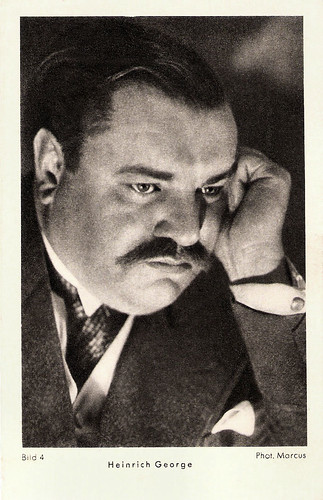
German postcard by Margarinewerk Eidelstedt Gebr. Fauser G.m.b.H., Holstein, Serie 1, no. Bild 4. Photo: Marcus.
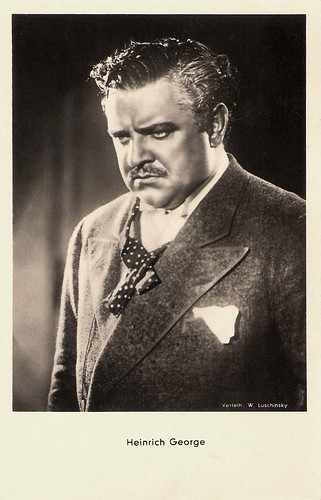
Austrian postcard by Iris-Verlag, no. 6305. Photo: Verleih W. Luschinsky.

Dutch collector card. Photo: Ufa. Heinrich George in the German period film Heimat (Carl Froehlich, 1938), based on a play by Hermann Sudermann.
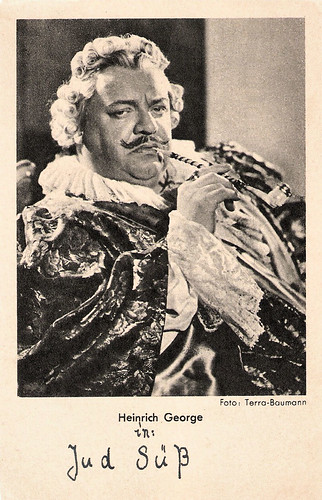
German postcard by Das Programm von Heute, Berlin. Photo: Baumann/Terra. Publicity still for Jud Süss (1940).
An arrangement
Heinrich George married German actress Berta Drews in 1932. They would have two sons: Jan George (1932) and the well-known actor Götz George (1938), but the marital bliss was soon interrupted by Hitler’s takeover of power in Germany in January 1933. During the 1920s, Heinrich George had been active in the Communist Party of Germany, and the Nazis did not permit him to continue work. The desperate actor made an arrangement with the fascist regime and played a communist who converts to National Socialism in the propaganda film Hitlerjunge Quex/Hitler Youth Quex (Hans Steinhoff, 1933) based upon the life and death of Hitler Youth Herbert Norkus, killed while distributing flyers in a Communist neighbourhood.
Hereafter the Nazis gave George an active role in their propaganda on film and radio. He became one of the leading representatives of Nazi cinema and proved himself to be a very versatile actor: in historic biopics such as Das unsterbliche Herz/The Immortal Heart (Veit Harlan, 1939) and Andreas Schlüter (Herbert Maisch, 1942), he portrayed powerfully charismatic leaders who insist on unconditional obedience. In the anti-Semitic Jud Süß/Jew Süss (Veit Harlan, 1940) he starred as a pleasure-seeking Duke who hands over his country to a Jewish financial advisor, and in Kolberg/Burning Hearts (Veit Harlan, 1945) he played a mayor who calls on his citizens to defend the city against the Napoleonic troops.
He also appeared in non-propaganda films, such as the Henrik Ibsen adaptation Stützen der Gesellschaft/Pillars of Society (Detlev Sierck a.k.a. Douglas Sirk, 1935), the Zarah Leander vehicle Heimat/Homeland (Carl Froelich, 1938), and the popular hit Der Postmeister/The Stationmaster (Gustav Ucicky, 1940) based on the story by Alexander Pushkin. In 1937 propaganda minister Joseph Goebbels named him ‘Staatsschauspieler’ (Actor of the State) and a year later he became artistic director of the Schiller Theater in Berlin. There he engaged several artists, who were ‘unerwünscht‘ (undesirable) by the regime. Among them were the art historian Wilhelm Fraenger who was fired in 1933 in Heidelberg for being a communist, the Catholic actor Robert Müller dismissed according to Nazi racial laws as a Jew, the communist graphic designer Karl Rössing and his pupil Günther Strupp. In December 1942, he took over his own department at the film production company Tobis.
After World War II, Heinrich George and his wife were arrested by the Soviet secret police. In June 1945, they were imprisoned in Berlin-Hohenschönhausen, and later interned in the former Nazi concentration camp Sachsenhausen, just north of Berlin. In 1946, Heinrich George died there at the age of 52. The death cause of the once so massive and powerful actor was starvation and exhaustion, even though official reports stated that he died ‘after an appendix operation’. The camp administration had urged the general practitioner, Dr. Schumann to do so.
In 1994, after the collapse of Communism and the removal of Soviet occupation troops from Germany, thousands of bones were found in the camp area. Heinrich George could be identified by comparing his DNA with that of his sons. The legendary actor got a final grave in a cemetery in Berlin and was officially rehabilitated in 1998. Once George had described his famous acting technique as ‘controlled trance’. Filmportal.de: “His best screen moments occurred in movies in which he could act in long unbroken scenes uninterrupted by reaction shots. Examples include his plea in Affäre Dreyfus (The Dreyfus Case) and the dance sequence in Der Postmeister”.
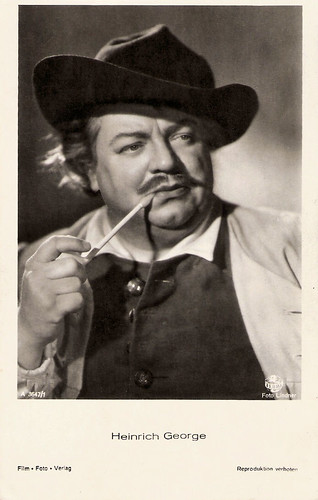
German postcard by Film-Foto-Verlag, no 3647/1, 1941-1944. Photo: Lindner / Terra. Publicity still for Andreas Schlüter (Herbert Maisch, 1942).

German postcard by Film-Foto-Verlag, no. A 3956/1, 1941-1944. Photo: Tobis / Star-Foto-Atelier.
Trailer Der Postmeister (1940). Source: Spuller (YouTube).
Sources: Film-Zeit.de (German), Wikipedia (English and German) and IMDb.
This post was last updated on 13 May 2024.
No comments:
Post a Comment